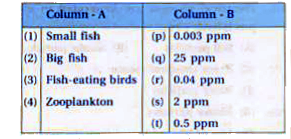Match the column. Column .

(A) (1→t),(2→s),(3→q),(4→r)
(B) (1→r),(2→t),(3→s),(4→p)
(C) (1→r),(2→s),(3→q),(4→p)
(D) (1−→p),(2→r),(3→t),(4→q)Solution in Gujrati
(1→t),(2→s),(3→q),(4→r)
(1→r),(2→t),(3→s),(4→p)
(1→r),(2→s),(3→q),(4→p)
(1−→p),(2→r),(3→t),(4→q)
The correct Answer is:A
Step by step video, text & image solution for Match the column. Column . (A) (1rarr t), (2rarrs), (3rarrq),(4rarr r) (B) (1rarr r), (2rarr t),(3rarrs),(4rarrp) (C) (1rarrr),(2rarrs),(3rarrq),(4rarrp) (D) (1-rarrp),(2rarr r),(3rarr t),(4rarr q) by Biology experts to help you in doubts & scoring excellent marks in Class 12 exams.
Topper's Solved these Questions
- BOOK - KUMAR PRAKASHANCHAPTER - ENVIRONMENTAL ISSUESEXERCISE - Section - F (Multiple Choice Question (MCQs))(MCQs ASKED IN COMPETITIVE EXAM)22videos
ENVIRONMENTAL ISSUES
- BOOK - KUMAR PRAKASHANCHAPTER - ENVIRONMENTAL ISSUESEXERCISE - Section - E (Solution of NCERT Exemplar)(Long Answer Type Questions )7videos
ENVIRONMENTAL ISSUES
- BOOK - KUMAR PRAKASHANCHAPTER - ECOSYSTEMEXERCISE - SECTION - F (MCQs ASKED IN COMPETTIVE EXAM)84videos
ECOSYSTEM
- BOOK - KUMAR PRAKASHANCHAPTER - EVOLUTIONEXERCISE - SECTION - F (Multiple Choice Questions)198videos
EVOLUTION
Similar Questions
Kyoto Protocol was endorsed at
(A) COP-3
(B) COP-5
(C) COP-6
(D) COP-400:59View SolutionWrite a short note on electronic waste. List the various sources of e-wastes and the problems associated with its disposal.
07:49View SolutionDecomposers are
04:12View SolutionWho proposed the theory of special creation ?
04:51View Solutioncos x+sec x=2rArr cos^(m)x+sec^(m)x=1-11
01:54View SolutionMatch the columns
Column IColumn IIaCartilagepNeurilemmabBoneqSarcolemmacMuscle FibrerPerichondriumdNeuronsPeriosteumtPericardium02:08View SolutionMatch the columns
Column IColumn IIaErythrocytespBonebChondrocytesqNeuroncOsteocytesrCartilagedSchwann cellssBlood−−tAdipose Tissue05:04View SolutionMatch the columns
Column I Column IIaHarversian CanalpKidneybDendritesqCartilagecSarcolemmarMuscledChondrocytes sNerve cells−−tBone02:24View SolutionIf A=⎡⎢⎣apbqcr⎤⎥⎦, then (AT)T = _________ .
01:34View SolutionMatch the columns {:(,"Column I",,"Column II"),(a,"Bicuspid valve",p,"Brain"),(b,"Nephron",q,"Liver"),(c,"Alveoli",r,"Heart"),(d,"Cerebrum",s,"Kidney"),(,,t,"Lungs"):}
03:18View SolutionIf the pth, qth and rth terms of a G.P. are a, b, c respectively, prove that: a(q−r).ˆb(r−p).c(p−q)=1.
04:38View Solution1H1+1H1+1H2→X+1e0+energy. The emitted particle is:
02:48View SolutionBalance the following chemical equation: HNO3+Ca(OH)2→Ca(NO3)2+H2O
02:40View SolutionMatch the columns
Column I Column IIaHarversian CanalpKidneybDendritesqCartilagecSarcolemmarMuscledChondrocytes sNerve cells−−tBone03:15View SolutionMatch the following columns.
Column IColumn IIA.Teslap[ML2A−2T−2]B.Weberq[MLA−2T−1]C.Weber m−2r.[MA−1T−2]D.Henrys.None02:13View SolutionMatch the columns {:(,"Column I " ,, "Column II") , (a , "Harversian Canal" , p , "Kidney"), (b , "Dendrites", q, "Cartilage" ), (c , "Sarcolemma" , r, "Muscle"), (d , "Chondrocytes " , s, "Nerve cells"), (- , - , t,"Bone"):}
03:27View Solution

